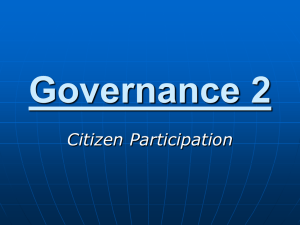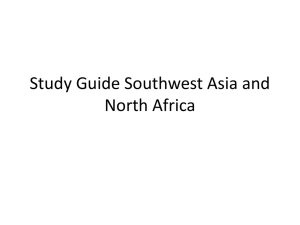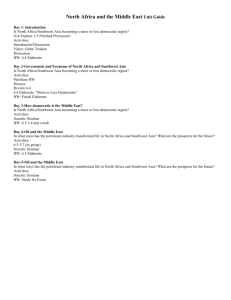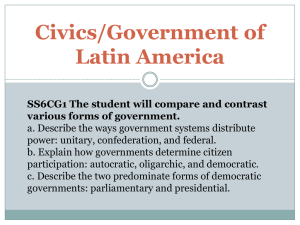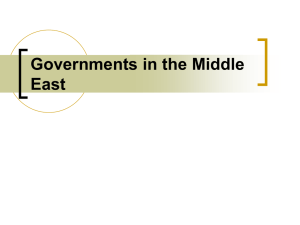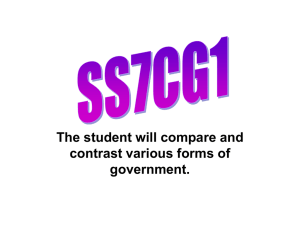Southwest Asia Unit Study Guide Answer Key Mid
advertisement
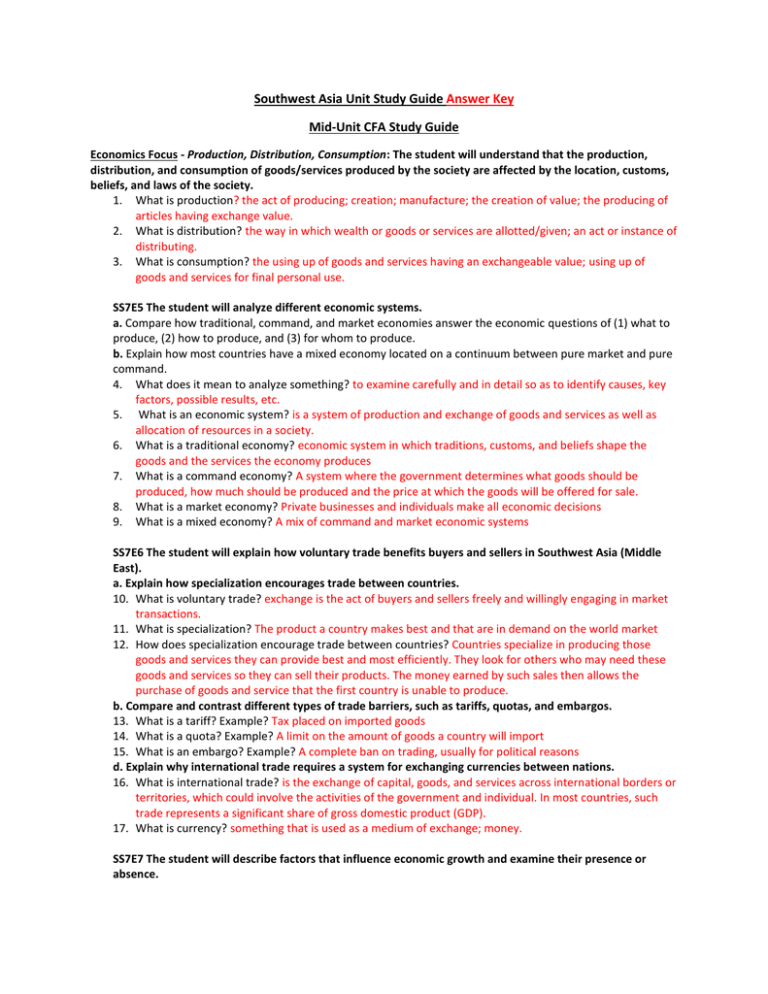
Southwest Asia Unit Study Guide Answer Key Mid-Unit CFA Study Guide Economics Focus - Production, Distribution, Consumption: The student will understand that the production, distribution, and consumption of goods/services produced by the society are affected by the location, customs, beliefs, and laws of the society. 1. What is production? the act of producing; creation; manufacture; the creation of value; the producing of articles having exchange value. 2. What is distribution? the way in which wealth or goods or services are allotted/given; an act or instance of distributing. 3. What is consumption? the using up of goods and services having an exchangeable value; using up of goods and services for final personal use. SS7E5 The student will analyze different economic systems. a. Compare how traditional, command, and market economies answer the economic questions of (1) what to produce, (2) how to produce, and (3) for whom to produce. b. Explain how most countries have a mixed economy located on a continuum between pure market and pure command. 4. What does it mean to analyze something? to examine carefully and in detail so as to identify causes, key factors, possible results, etc. 5. What is an economic system? is a system of production and exchange of goods and services as well as allocation of resources in a society. 6. What is a traditional economy? economic system in which traditions, customs, and beliefs shape the goods and the services the economy produces 7. What is a command economy? A system where the government determines what goods should be produced, how much should be produced and the price at which the goods will be offered for sale. 8. What is a market economy? Private businesses and individuals make all economic decisions 9. What is a mixed economy? A mix of command and market economic systems SS7E6 The student will explain how voluntary trade benefits buyers and sellers in Southwest Asia (Middle East). a. Explain how specialization encourages trade between countries. 10. What is voluntary trade? exchange is the act of buyers and sellers freely and willingly engaging in market transactions. 11. What is specialization? The product a country makes best and that are in demand on the world market 12. How does specialization encourage trade between countries? Countries specialize in producing those goods and services they can provide best and most efficiently. They look for others who may need these goods and services so they can sell their products. The money earned by such sales then allows the purchase of goods and service that the first country is unable to produce. b. Compare and contrast different types of trade barriers, such as tariffs, quotas, and embargos. 13. What is a tariff? Example? Tax placed on imported goods 14. What is a quota? Example? A limit on the amount of goods a country will import 15. What is an embargo? Example? A complete ban on trading, usually for political reasons d. Explain why international trade requires a system for exchanging currencies between nations. 16. What is international trade? is the exchange of capital, goods, and services across international borders or territories, which could involve the activities of the government and individual. In most countries, such trade represents a significant share of gross domestic product (GDP). 17. What is currency? something that is used as a medium of exchange; money. SS7E7 The student will describe factors that influence economic growth and examine their presence or absence. a. Explain the relationship between investment in human capital (education and training) and gross domestic product (GDP). 18. What is human capital? Education, healthcare, & training of a country’s workers 19. What is an investment? devoting, using, or giving of time, talent, emotional energy, etc., as for a purpose or to achieve something 20. What is the gross domestic product? Measures a country’s economy; all of the goods and services produced within a county in 1 year. b. Explain the relationship between investment in capital (factories, machinery, and technology) and gross domestic product (GDP). 21. What is capital? Technology, factories, & machines that are used to make/sell goods & services d. Describe the role of entrepreneurship. 22. What is an entrepreneur? Someone who takes a risk and starts a new business or invents a new product Government/Civics Focus: The student will understand that as a society increases in complexity and interacts with other societies, the complexity of the government also increases. 1. What is a theme? A topic, unifying idea, image, or motif, repeated or developed throughout a work 2. What is a society? a highly structured system of human organization for large-scale community living that normally furnishes protection, continuity, security, and a national identity for its members 3. What is complexity? something intricate or complex; complication 4. What does it mean to interact? is based on the idea that well-designed, consistent and regular interactions lead to increased productivity; a mutual or reciprocal action or influence SS7CG1, SS7CG4, SS7CG6 The student will compare and contrast various forms of government. a. Describe the ways government systems distribute power: unitary, confederation, and federal. b. Explain how governments determine citizen participation: autocratic, oligarchic, and democratic. c. Describe the two predominant forms of democratic governments: parliamentary and presidential. SS7CG1 The student will compare and contrast various forms of government. a. Describe the ways government systems distribute power: unitary, confederation, and federal. 5. How do government systems distribute power in a unitary government? Power is held by one central authority 6. How do government systems distribute power in a confederation? Power is shared by an alliance of independent states (or countries) 7. How do government systems distribute power in a federal government? Power is shared by a powerful central government and the state or local governments. b. Explain how governments determine citizen participation: autocratic, oligarchic, and democratic. 8. How do governments determine citizen participation in an autocratic government? Citizens cannot participate in the selection of the ruler or vote on the country’s laws. 9. How do governments determine citizen participation in an oligarchic government? The country is ruled by a small group of people. Citizens do not select the members of this group or vote on the country’s laws. (the group gets their power from either military force, religion, or wealth & resources). 10. How do governments determine citizen participation in a democratic government? Citizens hold the power; all citizens have the opportunity to vote for leaders & laws. c. Describe the two predominant (main) forms of democratic governments: parliamentary and presidential. 11. What is the make-up of a parliamentary government? Citizens vote for members of the legislature, not directly for the leader. The legislature then chooses the country’s leader among its members. 12. What is the make-up of a presidential government? Citizens vote directly for the leader of the country. Citizens also vote for members of the legislature but separately from the leader. The leader of the country does not make laws, legislature does this. Geography: 1. A man-made structure that connects Mediterranean Sea to Red Sea: Suez Canal 2. Small territory that has been source of dispute between Israel and neighbors for many years: Gaza Strip 3. Much of the world’s oil supply is shipped through this narrow waterway: Strait of Hormuz 4. This river is the key water source for Israel, Lebanon, & Syria: Jordan River 5. Because mountains block winds coming from the oceans, much of the interior of Southwest Asia is: Desert 6. Why is the Suez Canal so important to international shipping? It makes it possible to get from the Mediterranean to the red Sea without sailing around Africa 7. Which are connected by the Strait of Hormuz? Persian Gulf and Arabian Sea 8. What rivers are like twin rivers flowing through Turkey & Iraq? Euphrates and Tigris 9. What are three major problems in Southwest Asia? Water shortages, unequal distribution, pollution 10. Over the last 50 years, people have been leaving the nomadic life to live here: Cities 11. Which country has fought military battles over water rights to the Jordan River? Israel 12. Because of its harsh climate, which country has to rely on desalination plants to provide most of its citizens with drinking water? Saudi Arabia 13. Pollution from oil spills on the Black Sea contaminate this country’s water supply. Turkey 14. Decades of war has damaged this country’s water treatment facilities? Iraq 15. Which best describes the climate of much of Southwest Asia? Hot and dry 16. What are the three prominent religions in the Middle East? Judaism, Christianity, and Islam 17. What ethnic group lives in the mountains of Turkey and Iraq? Kurds 18. Where do most Middle Eastern Jews live? Israel 19. The majority of people in Southwest Asia belong to which ethnic group? Arab 20. Today, most Iranians speak Farsi and belong to this ethnic group: Persians 21. What is the oldest religion in Southwest Asia? Judaism 22. What issue led to the split between Sunni and Shia Muslims? They disagreed over who should lead the Muslims after Muhammad died. 23. What are the Five Pillars of Islam? Five basic obligations that Muslims are supposed to do at in their lifetime. 24. What best describes the religion of Arabs? Most are Muslim 25. Who is a common figure in the origins of Judaism, Christianity, and Islam? Abraham
